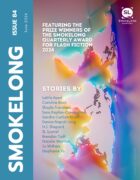Where did you find yourself drawing inspiration from when creating the character of Strong Female Character?
Strong Female Character was mostly a vibe that I got from watching iconic female detectives on TV. Clarice Starling in her Quantico sweats in the opening of Silence of the Lambs. Kate Winslet eating a hoagie in Mare of Easttown. I also had been watching a lot of true crime style cinema like Twin Peaks and True Detective, which lent to the mood of the piece. Although the story is titled Strong Female Character, it’s as much about the creepy world she inhabits. There is danger at every turn. There are murders that no one seems to notice. I wanted to create this uncanny reality for her and the reader. A lot of the story’s DNA is from Roberto Bolaño’s 2666, which I highly recommend to flash writers even though it is a 900-page novel. It’s very conducive to flash because much of it’s told in these very perfect, very surreal vignettes.
I like that Strong Female Character feels familiar, yet she doesn’t come across as a stereotype or a cliché. What was your process in striking that balance?
The strong female character has become such a trope and that was actually a starting point for me. I wanted to have an unnamed woman that embodied all of these stereotypes—the coffee, the diner, the grit. And then slowly you start to see glimpses of her interior—her fantasies, her dreams, the very specific thing she orders at the diner. I think those intimate details give her a life beyond cliché.
With Strong Female Character only using her last name as an adult feels like an erasure of a part of herself and her identity. Do you think this is indicative of her line of work, or something else?
I actually have a very hard time naming characters. If it doesn’t come to me in the first draft, no name I choose subsequently ever feels authentic. In every draft, Strong Female Character was unnamed. Eventually that became the story. To do the kind of work she does involves dissociation and repression. The fact that she calls herself by her last name shows the distance at which she keeps herself, probably to an unhealthy degree. By ending on a flashback, we’re seeing a time when she was less guarded and still had this hero’s instinct that had not yet been crushed by the oppressiveness of her world.
There seems to be a separation between Strong Female Character and the other characters in the story. Would you say this distancing is purposeful on her part?
It is purposeful. The world she moves around in is one where women and femmes end up dead, subjugated, or objectified. It’s not an easy place to inhabit, and I think, for Strong Female Character, it has taken its toll.
The way you use imagery within the story creates a cinematic narrative, like we’re watching a TV show. What level of this was intentional?
The seed of this story came from a dream that I had while I was pregnant and all my dreams were very intense and hormonal. The theater scene is what ultimately became of it. I knew early on I wanted to write a story from fractured pieces that melt into each other, like when you turn a kaleidoscope. I wrote a bunch of shards that I felt embodied the spirit of the initial dream and then did a ton of distilling and cutting. The story used to be a lot more complex with a serial killer and a murder plot and a huge climax. It became really unwieldy. I think the remnants of that initial grander story may be where the connection to cinematic narrative comes in, as well as the inspiration from films I talked about in response to the first question. Ultimately what made the final cut were the scenes that gave a different glimpse into this character in her world, small brushstrokes that left you with a sense of a greater whole.


